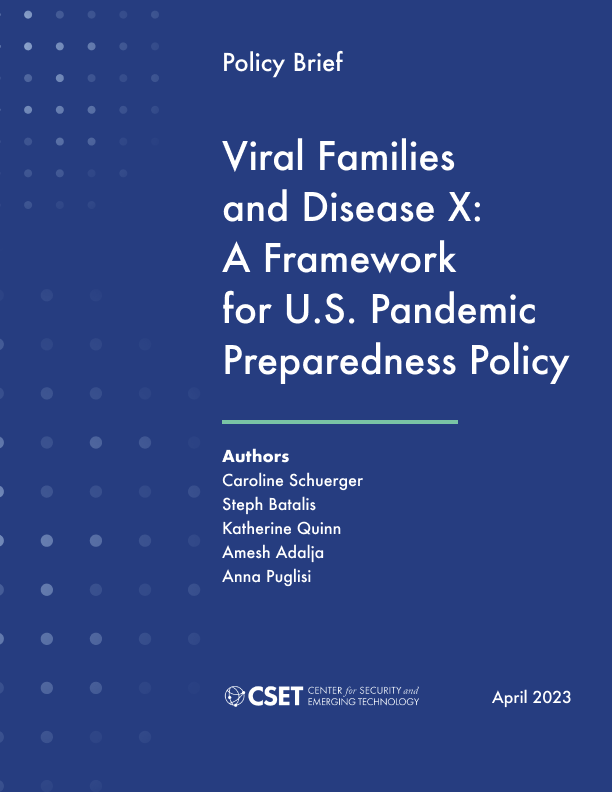Executive Summary
The threat of future pandemics is intensifying as globalization, urbanization, and encroachment on animal habitats cause infectious outbreaks to become more frequent and severe. To prepare for these future risks, the United States should proactively build a pipeline that encompasses the lifecycle of medical countermeasure development.
While the virus that causes the next viral pandemic has not likely yet emerged, we have identified seven viral families—groups of related viruses—that share pandemic-causing characteristics and are likely to yield the next pandemic virus. We assess that recognizing and prioritizing families of viral pathogens of pandemic potential (VPPPs), instead of individual viruses, will enable the United States to be better prepared. This approach would allow U.S. government officials and researchers to anticipate future threats, develop broad medical countermeasures (MCMs), and put in place foundational basic and applied research that can be used in a crisis.
We examined research publications, clinical trials, and the U.S. Food and Drug Administration-approved medical countermeasures to evaluate U.S. pandemic preparedness for VPPPs. Our key findings include the following:
The United States is not prepared to counteract a pandemic due to two factors: a lack of MCMs, and vulnerabilities in the manufacturing supply chain. Without pre-approved medical countermeasures—and the ability to rapidly produce and deploy them—the American public will not have essential therapies during an emergency.
- Only 43 MCMs are approved for all seven families of VPPP, and these include vaccines, small-molecule drugs, and antibody therapies.
- United States VPPP MCM manufacturing is vulnerable to supply chain disruptions due to limited domestic manufacturing and a lack of manufacturing redundancy; 30 percent of the MCMs are only manufactured abroad and 51 percent of MCMs are only manufactured at a single site.
There is inadequate VPPP research and development (R&D) to provide a foundation for pandemic preparedness, representing a system that reacts to—rather than prepares for—major outbreaks. The United States will lose valuable time during an outbreak if fundamental basic research and clinical developments are not already in place.
- The number of research publications and clinical trials peak after major outbreaks and then decline after the public health emergency has passed.
- VPPP publications have plateaued over time, even as total viral research increased.
- VPPPs make up only 14 percent of all virus-related research publications and 20 percent of all virus-related clinical trials despite presenting the greatest pandemic risk.
Based on our analysis, we propose that the United States government enact the following policy recommendations:
1. Include families of VPPP in pandemic preparedness strategies: We recommend including the seven viral families as priority pathogens for research funding and clinical trials to drive understanding and development of MCMs for pandemic preparedness.
2. Prioritize research and clinical trials for VPPPs in government-funding mechanisms in advance of public health emergencies: New public-private initiatives, like the Antiviral Program for Pandemics, created in 2021 and overseen by the National Institutes of Health and Biomedical Advanced Research and Development Authority (BARDA), are a good start for a forward-looking and multidisciplinary approach to VPPP R&D. Such initiatives should be continued and expanded.
3. Create a market for novel medical countermeasures to incentivize drug development: The federal government can drive MCM development by creating a market for MCMs to help balance private sector interests with national security needs. Many of these MCMs may not be used if an outbreak does not occur. U.S. programs should incorporate strategies to advance MCM candidates with early clinical testing and then pause development until the therapy is needed.
4. Onshore medical countermeasure manufacturing: The United States government should incentivize onshoring MCM manufacturing to protect the public’s access to critical therapies. Such priorities are already reflected in policy initiatives, such as the CHIPS and Science Act of 2022 and an executive order to expand biomanufacturing.
5. Build redundancy into the medical countermeasure supply: The United States government should incentivize diversifying MCM manufacturing across multiple sites to protect against supply chain disruptions that can occur when all production is at a single site.
